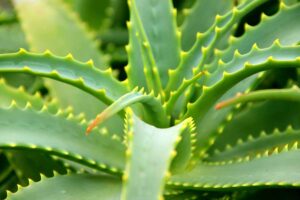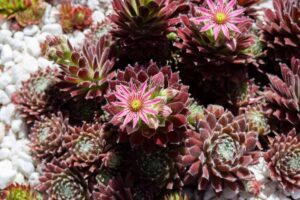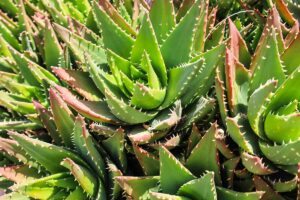Succulents don’t belong to one genus or flora family. They are various species from multiple genera with specific characteristics in common: fleshy stems and leaves that retain water under desert conditions.
In addition to being “water-wise,” enthusiasts like me appreciate succulents for their funky shapes. I often say they remind me of sea life, with forms resembling anemones, coral, jellyfish, sea urchins, sea lettuce, and seaweed.
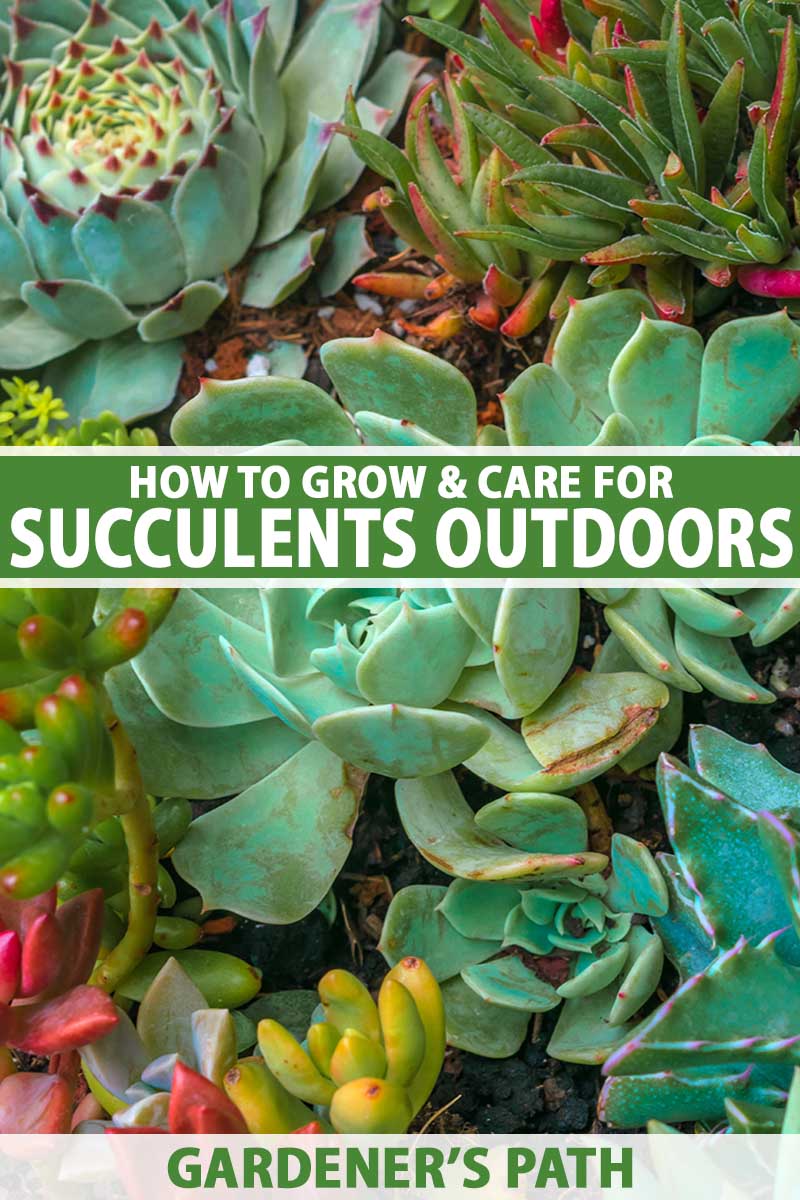
We link to vendors to help you find relevant products. If you buy from one of our links, we may earn a commission.
Popular houseplants, there are both tender and hardy varieties suited to outdoor cultivation in USDA Hardiness Zones ranging from 7 to 12. Frost-hardy types grow well in Zones 7 to 9, while tender species thrive in the hottest Zones, 10 to 12.
Join us as we explore succulents, their cultural requirements and care, species for various zones, and designs for low-maintenance outdoor displays.
Here’s the lineup:
What You’ll Learn
I enjoy working with succulents and think you will, too. Let’s get started!
Propagation
One of the best features of succulents, after their attractive forms, is the ease of propagation.
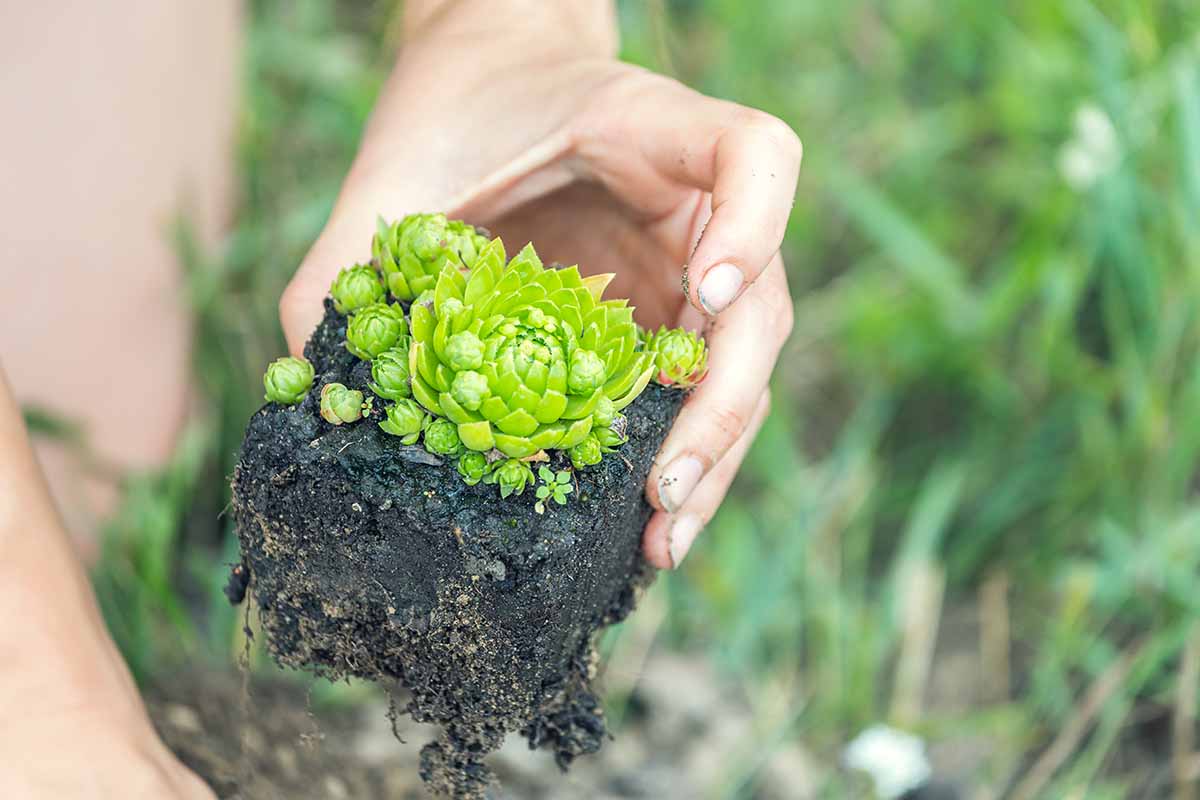
It’s easy to make new plants by:
- Dividing – offset removal or root separation
- Taking cuttings – leaf removal or beheading
It’s also possible to start with seeds, although this is the slowest method and seeds may not be readily available.
You’ll find detailed propagation instructions in our guide.
How to Grow
You’ll need a location with full sun to part shade for growing. Afternoon shade is beneficial if your locale is especially hot in the summer.
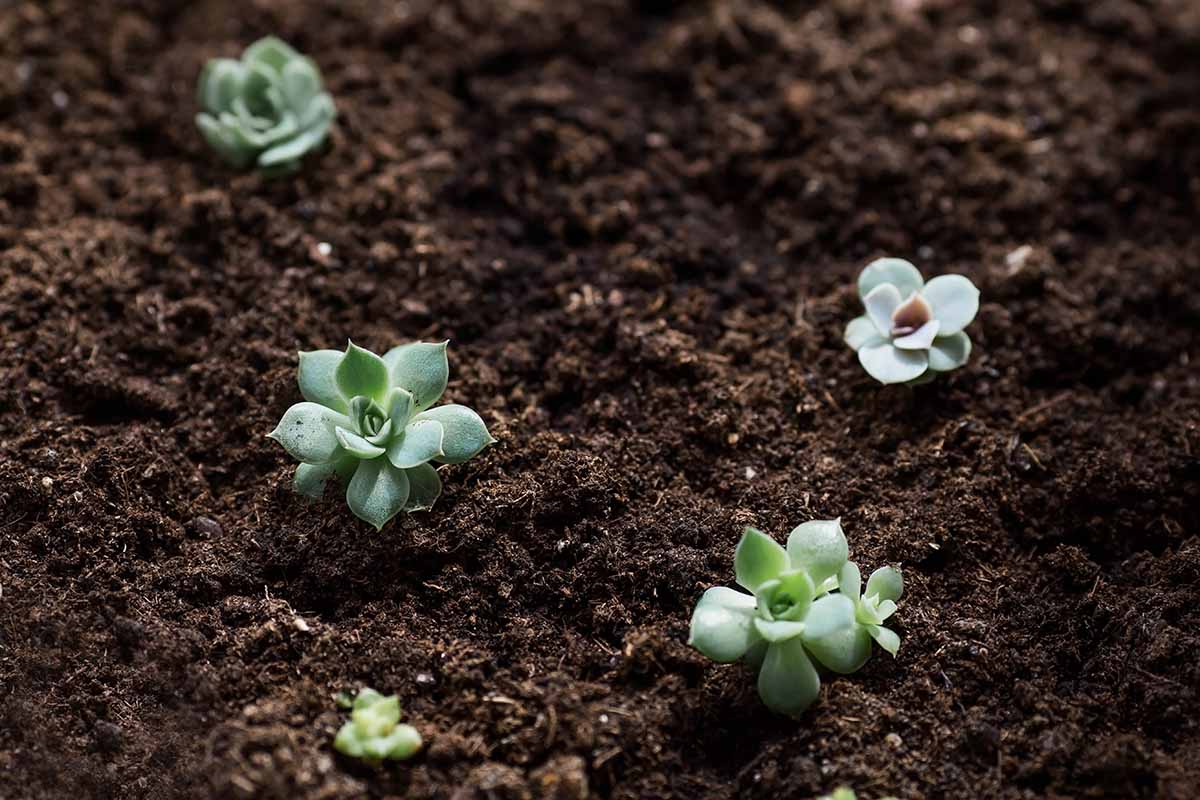
The soil should be sandy loam that drains well and has a slightly acidic pH balance of 5.5 to 6.5. If you like, you can conduct a soil test to determine the characteristics of your dirt.
You can amend it with humus and gritty horticultural sand to add organic matter and acidity, and improve drainage.
A sensible blend is 50 percent sand, 25 percent humus, and 25 percent existing soil. Be sure that the sand is for the garden and not builder or play sand, as these are very dense and inhibit drainage. We have detailed instructions for a DIY succulent soil mix here.
Read plant tags and seed packets and allow enough room for mature dimensions. Note that miniature varieties a few inches wide may produce offsets that spread a foot or more unless pruned or divided for transplanting.
When introducing new flora to an existing garden, be sure that the surrounding plants are also low-moisture species for one-size-fits-all care. The following perennials are excellent companion choices.
- Basket of Gold
- Bat-Faced Cuphea
- Desert Marigold
- Globe Amaranth
- Lantana
- Lavender
- Marigold
- Ornamental Grass
- Prickly Pear Cactus
- Salvia
- Snake Plant
- Turpentine Bush
- Yarrow
Follow the links to read our growing guides for each, and to determine their suitability for your growing zone.
It is best to plant when the weather is cool. For zones with frost, this is spring. For frost-free regions, plant in autumn.
Here’s how:
Mound the soil up four to six inches, so the foliage sits above ground level to promote drainage and inhibit rotting.
The roots are fragile and shallow, so handle them with care. Set each plant into its own mound, or mound the entire garden. Cover the roots with enough soil to anchor them firmly.

Set a hose nozzle to gentle, or use a sprinkler can to water the soil thoroughly. Avoid wetting the foliage to inhibit fungal growth.
Slant rosette-types, with a rounded cluster of leaves, slightly downward, so rainwater spills out of them. Planting high and avoiding water retention can go a long way toward inhibiting rotting, succulents’ nemesis.
The best way to water is to wait until the soil dries out completely and then water deeply.
It’s best to err on the side of neglect rather than generosity. Foliage is more likely to recover from being dry than from oversaturation. You may want to use a moisture meter as a guide.
You may find that when you test the soil for moisture at a depth of about two inches, you only need to water every three to four weeks, depending upon rainfall and temperature.
In-ground succulents are dormant during the hottest months of the year, and unlike their houseplant cousins that seldom bloom, flowering species grown outdoors may surprise you with blossoms in fall or winter.
Fertilizer is optional. You can apply half-strength liquid succulent food to miniature varieties and a full-strength dose to large specimens (in a quart-size nursery pot or larger) at planting time and each spring.
Apply fertilizer to the soil, not the foliage, to avoid leaf burn.
Growing Tips
Succulents grow well when you remember to:
- Provide sandy, well-draining soil
- Choose a location with full sun to part shade
- Leave room for spreading
- Choose companions with similar cultural requirements
- Mound the soil to avoid rotting
- Water infrequently and deeply
And finally, succulents are light feeders that don’t require fertilizer. Feed them sparingly, if at all.
Be sure to read our general succulent growing guide for more tips.
Pruning and Maintenance
Succulents are fairly self-sufficient.
Keep the garden free of weeds and leaf litter that may block sunlight and compete for water.
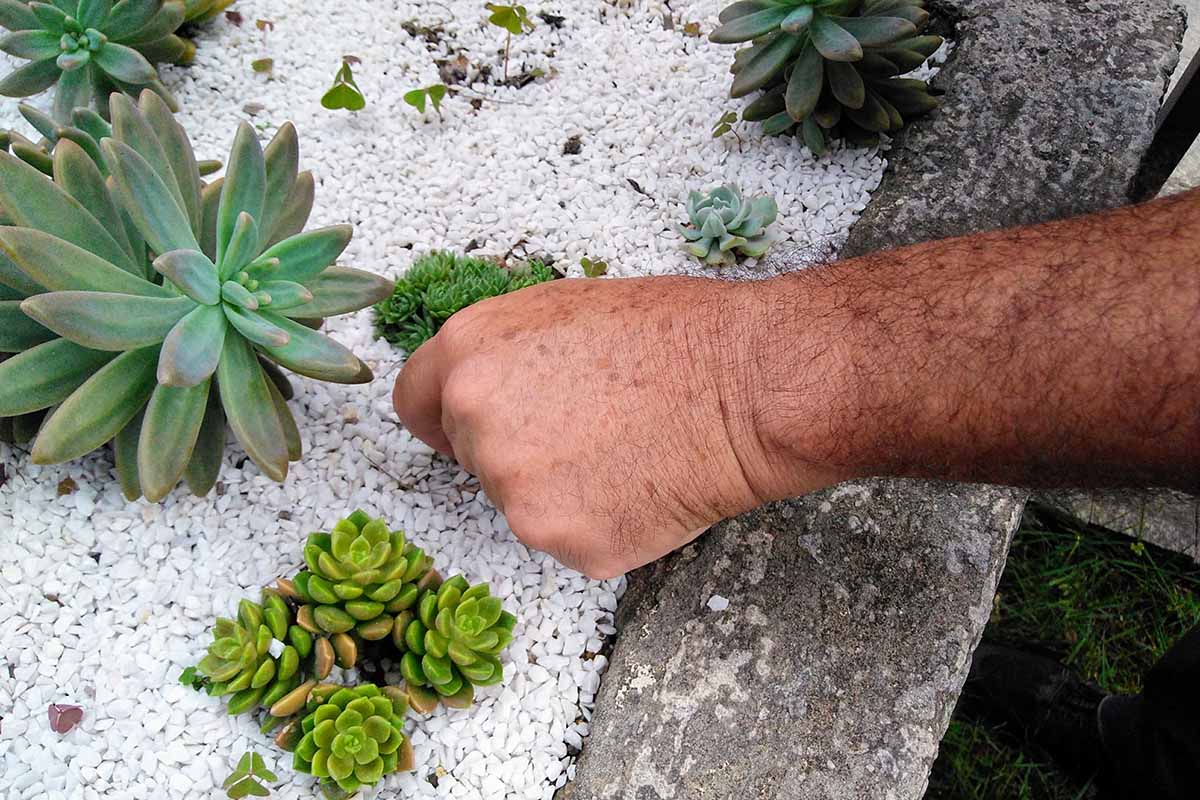
Use clean pruners to snip off damaged, rotted, or desiccated leaves that you notice during the growing season.
You may also want to prune leggy plants. When there isn’t enough sunlight available, some species stretch toward the light.
Cut scraggly stems just above a leaf node to promote bushier growth. Relocate to a brighter location in the spring in Zones 7 to 9 or in the fall in Zones 10 to 12.
On the other hand, you may notice that some plants are shading from green to pink, red, or orange.
They may be receiving too much direct sunlight. Consider relocating them, or planting taller plants nearby to create dappled afternoon shade, if you don’t care for the color change, or the foliage begins to turn brown from overexposure.
Another reason for plants to turn color may be over- or underwatering.
Jade plant is a good example of a specimen that shades to yellow with too much moisture. Evaluate your watering habits and make adjustments as needed to maintain optimal health and appearance, and prevent rotting.
Some species bloom once and die. Others live on to bloom again. Remove dead foliage and spent flowers, including their stems, to inhibit opportunistic pests and pathogens.
Use pruners to sever offsets from mother plants and transplant them as desired. This is a spring task in Zones 7 to 9, and a fall one in Zones 10 to 12.
Replace loose or damaged bricks, rocks, or other hardscape materials used in or around plants to avoid damage to delicate specimens and keep the soil from washing away.
In cooler Zone 6 and below, it may be possible to grow certain types of succulents outdoors in the summer in containers or the ground, and bring them to a sheltered location to overwinter indoors. Be sure to check plants thoroughly for pests and signs of disease before doing so.
Where to Buy
Here are seven succulent species to get you started. Note the recommended growing zones for each to make appropriate selections for your yard.
Ghost Plant
Hardy ghost plants, Graptopetalum paraguayense, grow well in Zones 9 to 11.

They produce four-inch rosettes and may achieve heights of up to 12 inches. A full sun to part shade placement is best. They prefer low to medium moisture.
Find ghost plants from USKC via Amazon.
Hens and Chicks
Suited to Zones 4 to 9, hardy hens and chicks, Sempervivum tectorum, are three to six inches tall and nine to 12 inches wide. The rosettes range from three to 10 inches in diameter. Mature S. tectorum are the hens, and offsets are the chicks.

Watering needs are low to medium and afternoon shade is best in the warmest zones. The foliage is deer and drought tolerant. Once a rosette blooms, it dies.
Find hens and chicks now from Fat Plants San Diego Store via Amazon.
Learn more about caring for Sempervivum or hens and chicks here.
Jade Plant
Tender jade plants, Crassula ovata, thrive in the warmest zones, 11 to 12, where they grow from three to six feet tall and two to three feet wide.
They appreciate bright morning light and afternoon shade. Although they are drought-tolerant, their moisture needs are moderate.
Find jade plants from Hirt’s Gardens Store via Amazon.
Or find tips on jade plant care here.
Kalanchoe
Unlike many succulents we grow primarily for their foliage, the main attraction of tender kalanchoe, Kalanchoe blossfeldiana, is its clusters of gold, pink, or red blossoms.

Suited to Zones 10 to 12, kalanchoe prefers filtered sunlight to light shade and achieves a mature stature of 18 inches tall and wide.
Find kalanchoe from Hirt’s Gardens Store via Amazon.
Or read more about the care of plants in the Kalanchoe genus here.
Living Stones
Tender living stones, Lithops, have the look of finely detailed rocks. They thrive in Zones 10 and 11, where they prefer full sun tempered by afternoon shade.

At one inch tall and one to three inches wide, they are petite treasures that like a dry environment and require little water.
Find living stones now from the Micro Landscape Design Store via Amazon.
Learn more about growing living stone plants here.
Stalked Aeonium
Tender-stalked aeoniums, Aeonium undulatum grow well in Zones 10 and 11, where they reach a height of two to three feet and a width of one to two feet.
Unlike many succulent species, stalked aeoniums are shrub-like, with branching bark-covered stems.

They prefer full sun to part shade and dry to medium moisture.
Find stalked aeonium from USKC via Amazon.
String of Pearls
Hardy string of pearls plants, Senecio rowleyanus, thrive in Zones 9 to 12.

They achieve mature dimensions of one to two feet tall and wide and prefer full sun to part shade. This species has low water needs and is drought tolerant.
Find string of pearls now from Fat Plants San Diego Store via Amazon.
Learn more about how to grow string of pearls in our guide.
In addition to these exciting examples, there are many more types to explore, such as:
Mix and match colors, shapes, sizes, and textures for rich and varied arrangements that showcase the unique features of each. And if you fall in love with a species that isn’t suited to outdoor cultivation in your growing zone, you have three options:
- Grow it indoors as a houseplant year-round.
- Place your selection in a terracotta pot that “breathes,” and set the entire pot in the ground during the growing season. Then dig up the pot and bring it in for winter. Return it to the garden next spring, after your zone’s last average frost date passes.
- Plant directly in the garden. Dig the tender specimen up before frost, pot it, and bring it inside. Then replant in the ground after the danger of frost passes.
Managing Pests and Disease
Once you have your favorites in place in the garden, there are some pests to watch out for, including:
In addition to pests, hungry wildlife may take a few nibbles, including squirrels and deer.
There are also a few diseases you should be aware of, like:
- Leaf spot
- Powdery mildew
- Root rot
While it is possible to treat sap-sucking pests and fungal diseases with neem oil, avoiding moisture stress is the best defense against both. Flora that is too dry or too wet is vulnerable.
In addition, oversaturation – the nemesis mentioned above – may cause root rot, so err on the side of neglect. Your plants will benefit!
Creative Design Schemes
Whether you dedicate a garden space to succulents or incorporate them into an existing low-maintenance landscape, succulents enhance outdoor living spaces with their varied forms, colors, and textures.
Use hardscape materials like bricks and stones to contain them and contrast with their soft forms.
If you are adding to an existing garden, consider the watering needs of neighboring flora. Keep the companions we discussed in mind when designing new spaces.
Succulents are versatile. You may enjoy them in the following settings:
- Beds
- Borders
- Drifts
- Edging
- Raised Beds
- Rock Gardens
- Slopes
- Xeriscapes, or Water-Wise Gardens
And now, let’s look at some exemplary designs to spark your imagination.
White pebbles and lawn edging neatly set off this small island of sempervivum. Landscape fabric beneath the stones suppresses weeds. In addition to being attractive, they keep lawn mowers away from tender foliage.
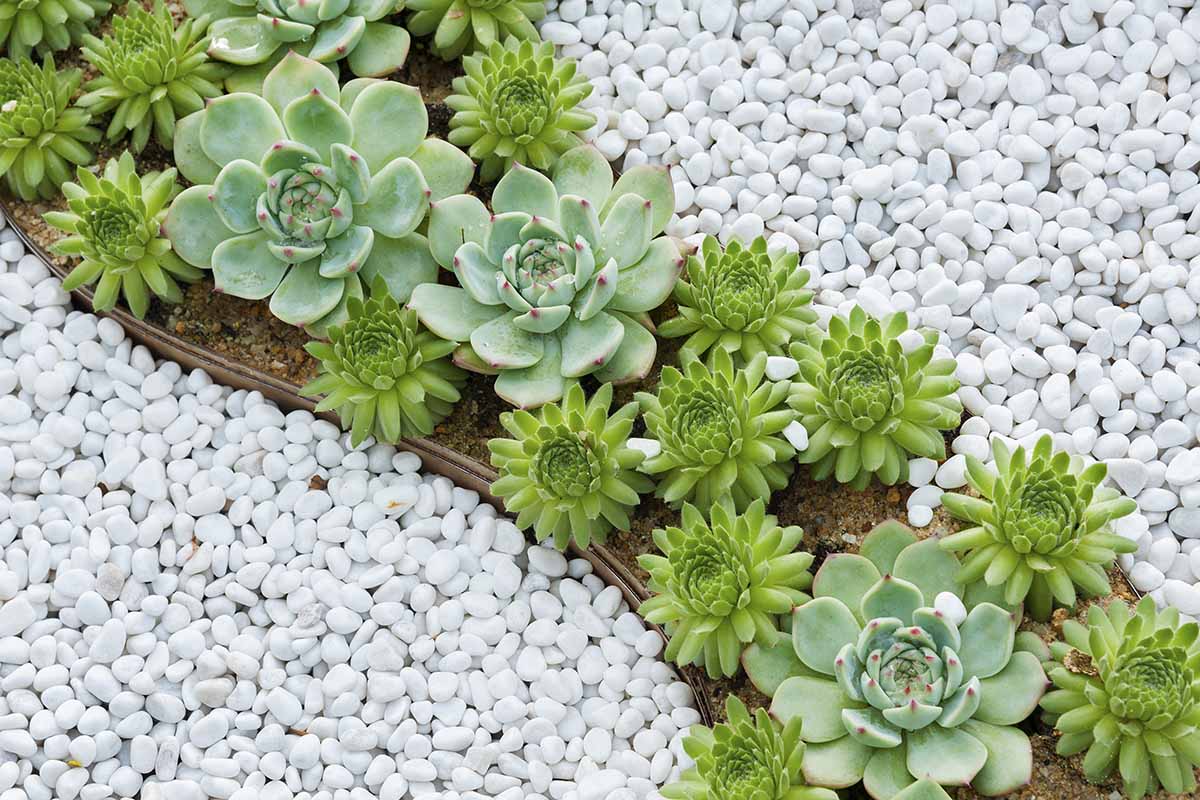
You might want to spice up an arrangement with a novelty like this terracotta urn that seems to be spilling echeveria from its wide mouth. Specimens in the mound of soil at the urn’s opening soon root in the ground soil around it.
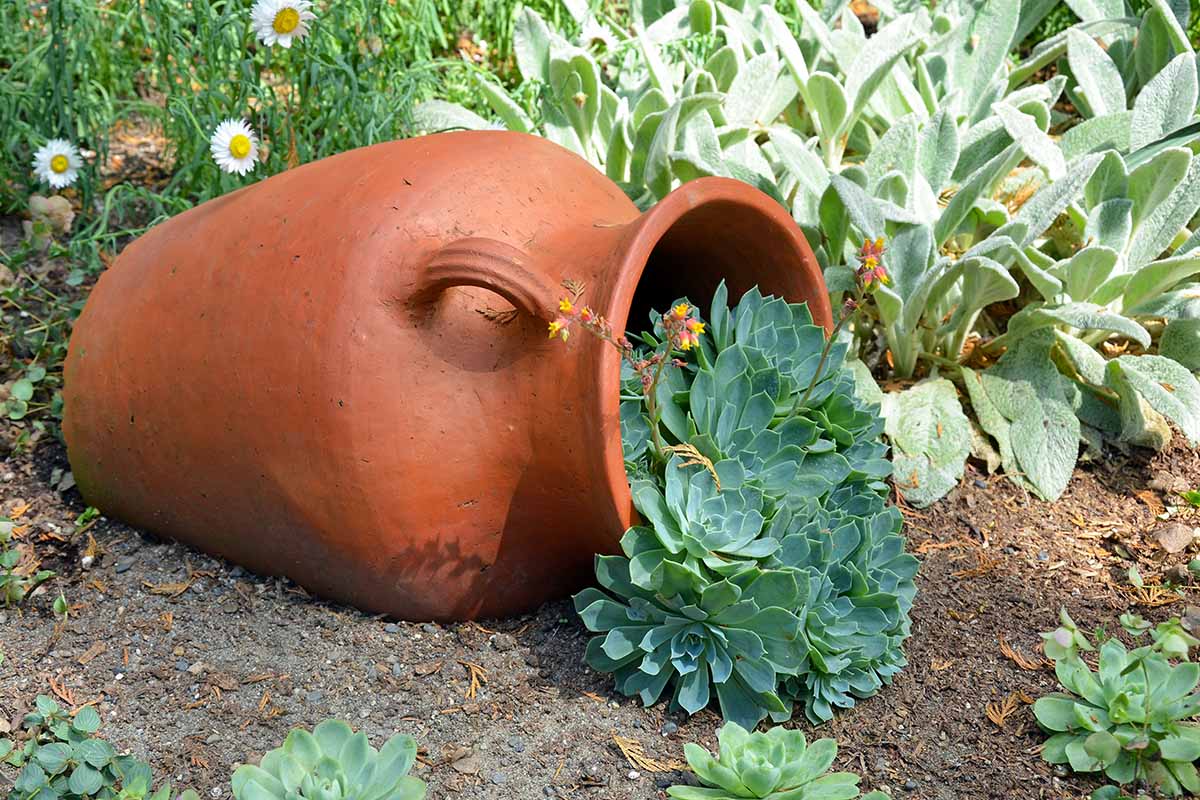
In another example, aloe nestles in the nooks and crannies of the crevices of a rock outcropping for a dramatic presentation.

An excellent way to achieve the four- to six-inch mounded soil needed for planting is to raise the entire garden, such as this one bordered by a low-profile natural stone wall.
The elevation shows the various species to best advantage and clearly defines a succulent watering zone.
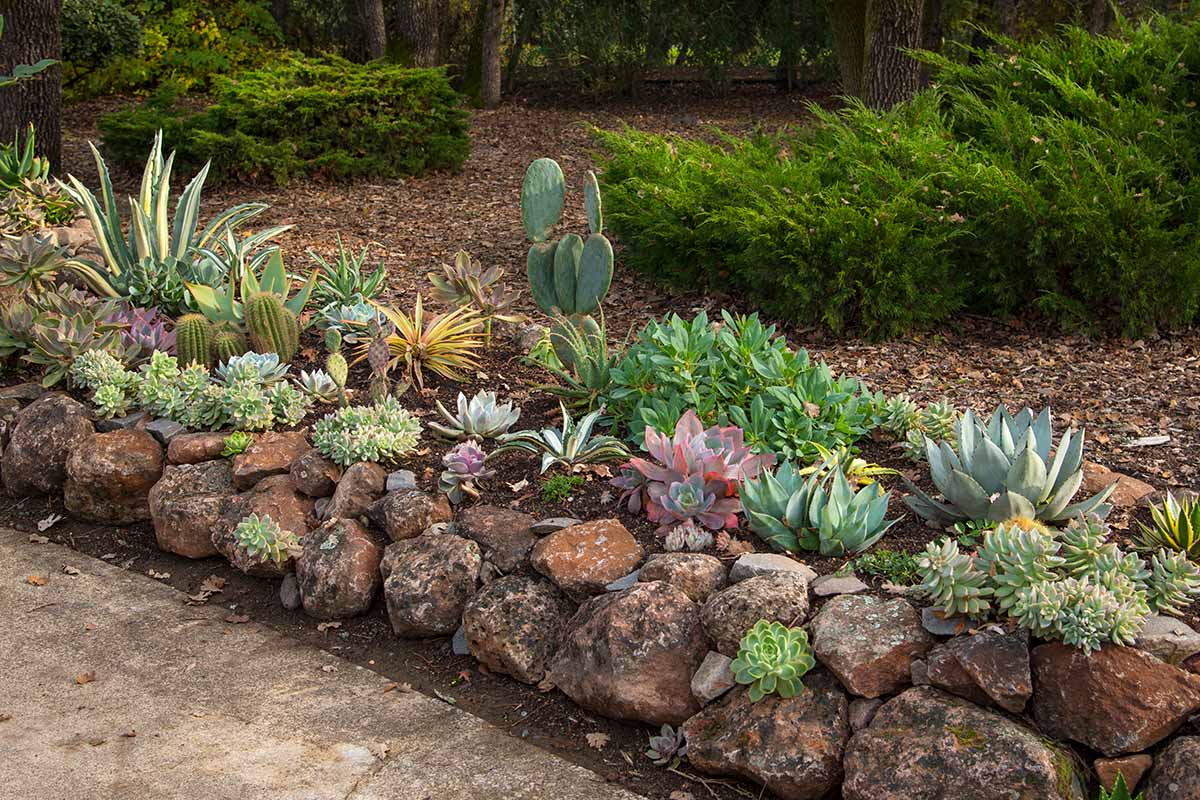
Remember to consider mature dimensions when planting because the space between varieties narrows as they grow and produce offsets. If you want to keep specimens separate, remove the offsets.
In this example, echeveria and sedum obscure the bare soil as they spread like mosaic artwork.
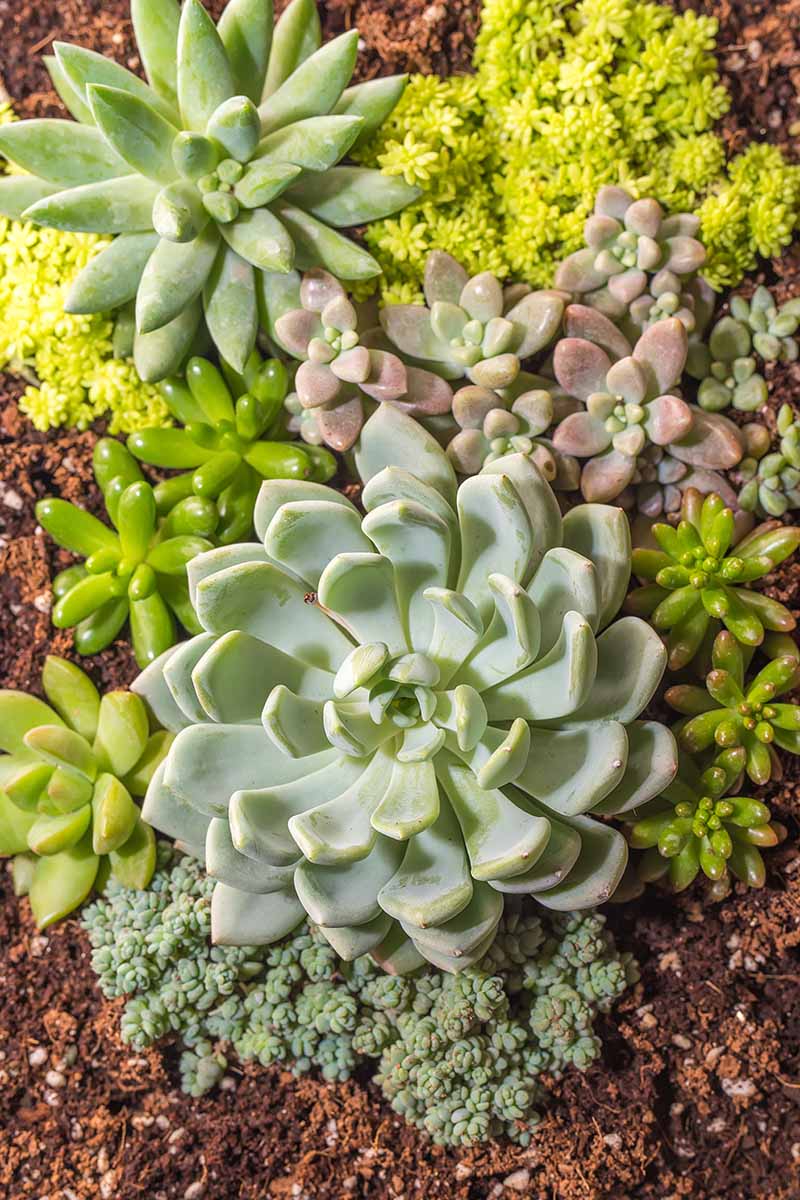
This garden is in the hollow of a natural stone bench. If you have interesting architectural elements in the landscape, you may try your hand at tucking succulents into them for a surprise attraction.
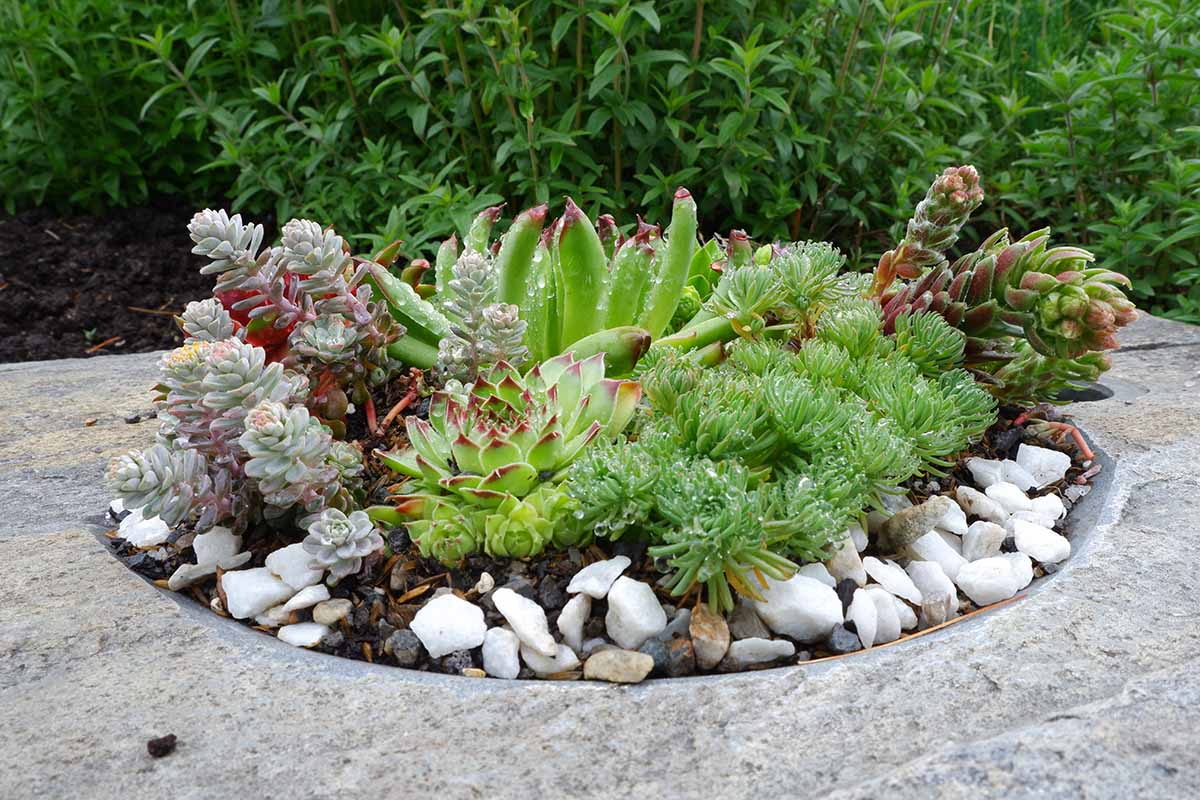
Consider filling the nooks and crannies of a piled stone wall with potting medium and nestling your favorites inside. Living walls contribute to green spaces and provide habitat for wildlife.
In this example, sedum and ghost plants find a comfortable home.
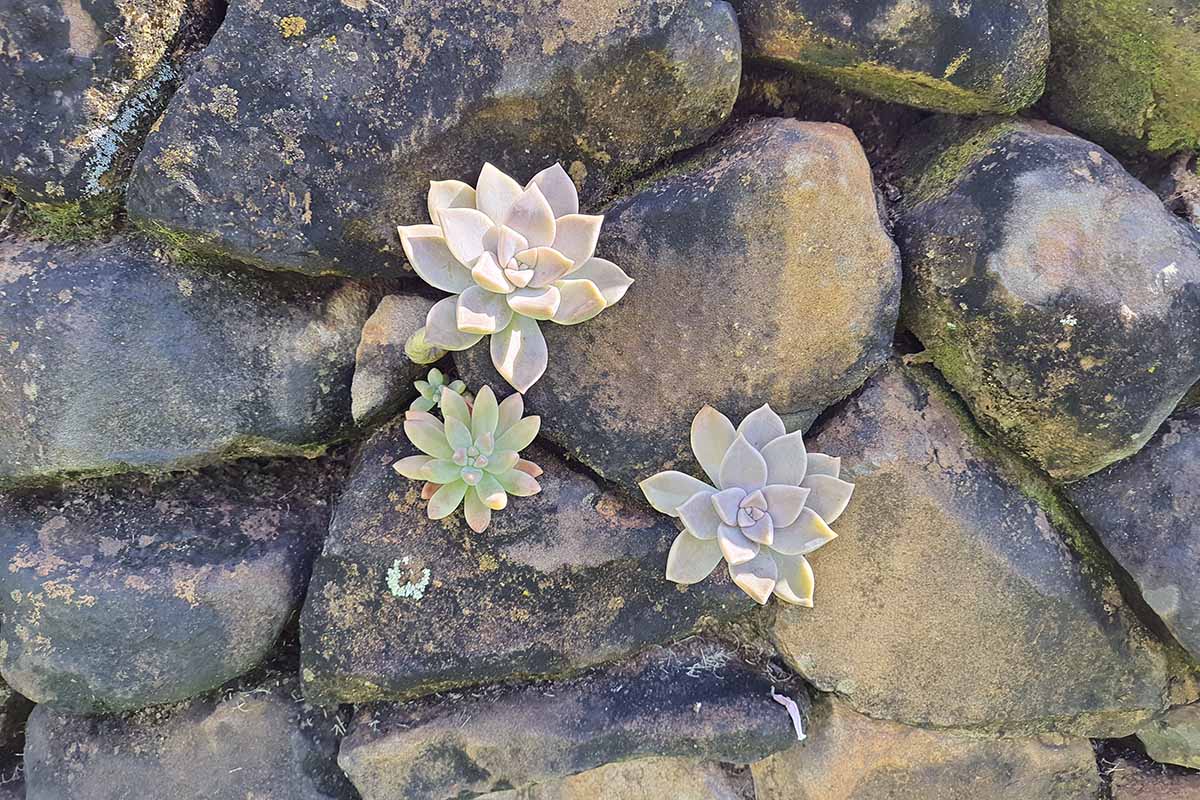
And if a large-scale desertscape is what you crave, here’s a front yard that features bold green and red agave amid lower profile blue chalk sticks, Senecio mandraliscae. Both are suited to Zones 10 and 11.
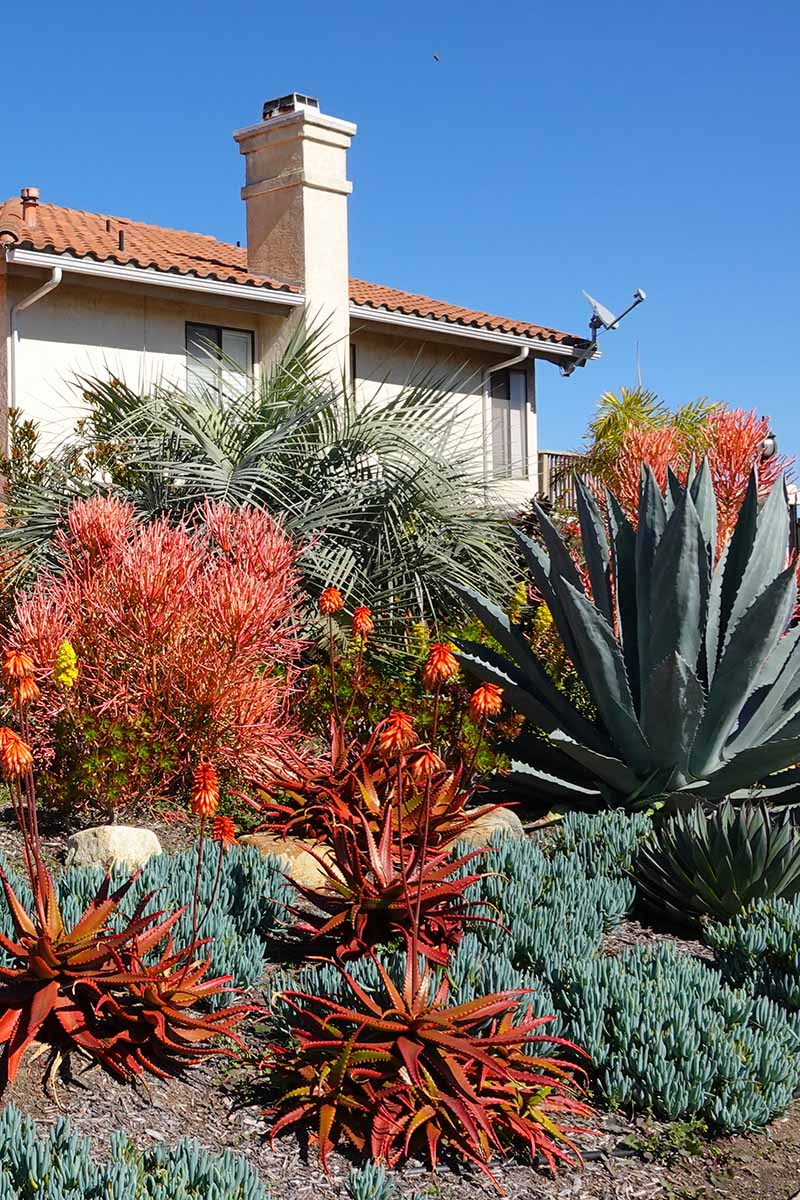
As you can see, there are many ways to enjoy in-ground succulent varieties!
Whimsical and Imaginative
We’ve covered a lot of material. Let’s wrap up.
If you live in Zones 7 to 12, there are succulents that you can incorporate into your landscape. Whether you accent existing gardens or design dedicated spaces, I know you’ll appreciate the unique colors, shapes, and textures they contribute.
Now’s the time to take out your garden planner!
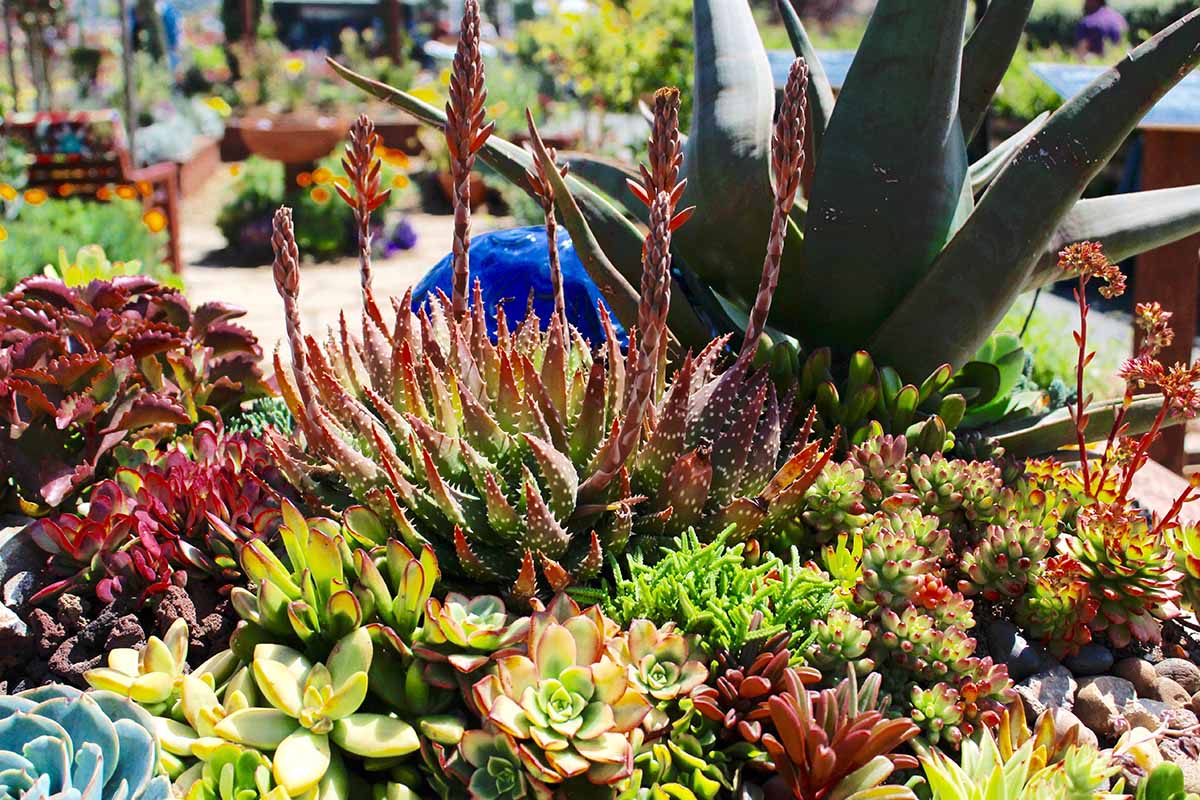
You can use this information as a guide to choosing whimsical species and creating imaginative displays at your house.
Do you grow succulents in your gardens? Please tell us about your favorites in the comments section below.
If you would like to read more about succulent cultivation, we recommend the following next:
